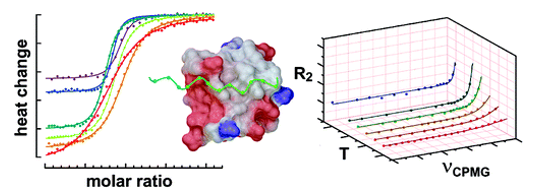Reaction Kinetics Examination
NMR spectroscopy can be used for monitoring reaction progress. Substrate consumption and product formation may be recorded over time by the change of peak integration. The rate of reaction could be obtained by taking the derivative of a fit to the experimental curve. Supported by the fully equipped NMR platform, Creative Biostructure is able to perform reaction kinetic examination and reaction monitoring by NMR for research projects in biochemistry, material science, and drug discovery.
 Figure 1. Reaction Kinetics can be calculated by fitting experimental curves
Figure 1. Reaction Kinetics can be calculated by fitting experimental curves
Kinetics play important role in understanding reaction mechanism. The information derived from kinetics studies can be used to optimize the fundamental of the reaction, for instance, benefit drug design, drug metabolism, and other related industrial and research process. Various analytical techniques have been used for studying kinetics data. Among these techniques, spectroscopy tools are particularly useful method. NMR spectroscopy can not only provide the kinetics data at molecular level, but also structural information during the reaction, which make it a powerful tool to investigate chemical reaction kinetics. Knowledge of protein dynamics could provide deep understanding of protein functions and further engineering protein behavior. NMR spectroscopy has became a pivotal technology in terms of structural biomolecular studies and protein dynamic, especially, the studies of the large proteins with high molecular weight. Protein-ligand binding properties can be characterized by NMR, including binding affinity and mechanisms. Recent studies showed that molecular dynamic over a wide time range by NMR is also possible, and development in hardware, theory and application reveal an exciting trajectory.
Reaction progress NMR may be classified as an integral analytical technique since the primary data collected are proportional to concentration vs time. While it is very convenient for well defined systems with distinctive, isolated product or reactant peaks. NMR observation may allow for the identification of a reaction intermediates, the presence of products over the course of the reaction. Reaction progress NMR may, however, often be run at variable temperature, allowing the rate of reaction to be adjusted to a level that is convenient for observation. Thus, it has been used to monitor the formation of polymers. It can not only characterize the chemical structure and chain extension reaction of polymers, but also investigate kinetics for the two thiol-ene reaction.
The NMR team at Creative Biostructure has extensive experience with reaction kinetics examination and reaction progress monitoring of both small organic molecules and biomacromolecules, and our specialist can teamwork with our customers to accelerate their research progress. Please contact us for detailed inquiry!
Ordering Process
References
- Mathew J., Klussmann M., Iwamura H., Valera F., Futran A., Emanuelsson E., and Blackmond D., (2006). Investigation of Pd-catalyzed ArX coupling reactions informed by reaction progress kinetic analysis. J. Org. Chem. 71: 4711-4722.
- Demers J., and Mittermaier A., (2009). Binding mechanism of an SH3 domain studied by NMR and ITC. J. Am. Chem.Soc. 131 (12): 4355-4367.
